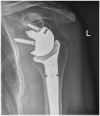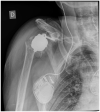An update on reverse total shoulder arthroplasty: current indications, new designs, same old problems
- PMID: 33841918
- PMCID: PMC8025709
- DOI: 10.1302/2058-5241.6.200085
An update on reverse total shoulder arthroplasty: current indications, new designs, same old problems
Abstract
Reverse total shoulder arthroplasty (RTSA) was originally developed because of unsatisfactory results with anatomic shoulder arthroplasty options for the majority of degenerative shoulder conditions and fractures.After initial concerns about RTSA longevity, indications were extended to primary osteoarthritis with glenoid deficiency, massive cuff tears in younger patients, fracture, tumour and failed anatomic total shoulder replacement.Traditional RTSA by Grammont has undergone a number of iterations such as glenoid lateralization, reduced neck-shaft angle, modular, stemless components and onlay systems.The incidence of complications such as dislocation, notching and acromial fractures has also evolved.Computer navigation, 3D planning and patient-specific implantation have been in use for several years and mixed-reality guided implantation is currently being trialled.Controversies in RTSA include lateralization, stemless humeral components, subscapularis repair and treatment of acromial fractures. Cite this article: EFORT Open Rev 2021;6:189-201. DOI: 10.1302/2058-5241.6.200085.
Keywords: acromion fracture; arthroplasty; design; indications; reverse; shoulder; subscapularis repair.
© 2021 The author(s).
Conflict of interest statement
ICMJE Conflict of interest statement: GW reports consulting fees, Support for travel to meetings for study or other purposes and royalties from Wright, related to the submitted work. The other authors declare no conflict of interest relevant to this work.
Figures




References
-
- Grammont PM, Baulot E. Delta shoulder prosthesis for rotator cuff rupture. Orthopedics 1993;16:65–68. - PubMed
-
- Australian Orthopaedic Association National Joint Replacement Registry. Hip, Knee & Shoulder Arthroplasty Annual Report 2019. Adelaide: AOA, 2019.
-
- Walch G, Bacle G, Lädermann A, Nové-Josserand L, Smithers CJ. Do the indications, results, and complications of reverse shoulder arthroplasty change with surgeon’s experience? J Shoulder Elbow Surg 2012;21:1470–1477. - PubMed
-
- Wall B, Nové-Josserand L, O’Connor DP, Edwards TB, Walch G. Reverse total shoulder arthroplasty: a review of results according to etiology. J Bone Joint Surg Am 2007;89:1476–1485. - PubMed
-
- Sevivas N, Ferreira N, Andrade R, et al. . Reverse shoulder arthroplasty for irreparable massive rotator cuff tears: a systematic review with meta-analysis and meta-regression. J Shoulder Elbow Surg 2017;26:e265–e277. - PubMed
Publication types
LinkOut - more resources
Full Text Sources
Other Literature Sources

